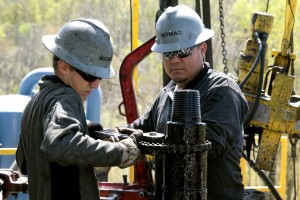What happened to 160,000 fracking jobs? Under Wolf, the numbers change

AP Photo/Ralph Wilson
Last week Pennsylvania changed the way it counts jobs associated with the Marcellus Shale industry.
Somehow Pennsylvania lost 160,000 gas industry jobs overnight.
What happened? Did drillers flee at the specter of a new tax on production? Not quite. Although companies have been laying off workers and cutting costs– lackluster market conditions don’t explain this shift.
Instead, it was a decision made under Governor Wolf’s new administration. Last week the state Department of Labor and Industry quietly changed the way it tracks employment in the Marcellus Shale industry.
“Those numbers were a joke,” says John Hanger, Wolf’s secretary of planning and policy. “The errors were so glaring, they had to be changed.”
Wolf’s predecessor Tom Corbett, a Republican, often credited drillers with supporting more than 200,000 Pennsylvania jobs.
“We were very uncomfortable with some of the misrepresentations under the past administration,” says labor department spokeswoman Sara Goulet. “The numbers we put out had caveats. [The Corbett administration] was misrepresenting them.”
As StateImpact Pennsylvania has previously reported, the way the state reported gas jobs had been repeatedly questioned over the years by independent economists.
Roughly 30,000 people work directly in six “core” oil and gas industry jobs. But starting in 2011, the labor department began publishing a monthly booklet called Marcellus Shale Fast Facts, which showed about 200,000 other jobs in 30 “ancillary” industries. This figure included every road construction worker, trucker, and steel worker in Pennsylvania– whether they had ties to the gas industry or not. The two numbers (core and ancillary) were often added together by industry boosters, who then claimed the Marcellus Shale supported a quarter-million jobs statewide.
In its new analysis, the labor department credits the gas industry with 89,314 jobs during the third quarter of 2014. The figure includes direct jobs and those in related industries. The department used a economic analysis software tool called IMPLAN (Impact Analysis for Planning) to calculate the number.
“That’s an important number,” says Hanger. “It’s an impressive number.”
Overall, it’s 160,122 fewer jobs than the department recently reported for the same quarter, using its old accounting method. David Spigelmyer who heads the gas industry trade group, the Marcellus Shale Coalition, criticized the change as being politically motivated. Drillers are in the midst of fighting Wolf’s proposal to levy new severance tax on gas production.
“This administration’s words continue to be detached from its actions as it relates to policy matters and enhancing Pennsylvania’s energy leadership,” Spigelmyer said in a statement. “Why put this important economic analysis in the hands of the governor’s political team rather than relying on career state policy analysts?”
Hanger disputes that characterization– noting the department didn’t issue a press release or make any announcement about the changes.
“I think that goes to further proof we were not being political,” he says. “The career staff over at [Labor and Industry] did this analysis. I didn’t do this. This is an attempt to provide people with good information about this industry. Nothing more, nothing less.”
















